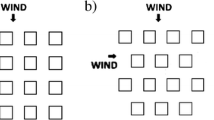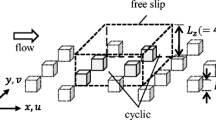Abstract
The aerodynamic effects of various configurations of an urban array were investigated in a wind-tunnel experiment. Three aerodynamic parameters characterising arrays—the drag coefficient (C d ), roughness length (z o) and displacement height (d)—are used for analysis. C d is based on the direct measurement of the total surface shear using a floating element, and the other two parameters are estimated by logarithmic fitting of the measured wind profile and predetermined total drag force. The configurations of 63 arrays used for measurement were designed to estimate the effects of layout, wind direction and the height variability of the blocks on these parameters for various roughness packing densities. The results are summarised as follows: (1) The estimated C d and z o of the staggered arrays peak against the plan area index (λ p ) and frontal area index (λ f ), in contrast with values for the square arrays, which are less sensitive to λ p and λ f . In addition, the square arrays with a wind direction of 45° have a considerably larger C d , and the wind direction increases z o/H by up to a factor of 2. (2) The effect of the non-uniformity of roughness height on z o is more remarkable when λ f exceeds 20%, and the discrepancy in z o is particularly remarkable and exceeds 200%. (3) The effect of the layout of tall blocks on C d is stronger than that of short blocks. These results indicate that the effects of both wind direction and the non-uniformity of the heights of buildings on urban aerodynamic parameters vary greatly with λ p and λ f ; hence, these effects should be taken into account by considering the roughness packing density.
Similar content being viewed by others
References
Bottema M (1997) Urban roughness modelling in relation to pollutant dispersion. Atmos Environ 31: 3059–3075
Burian SJ, Brown MJ, Linger SP (2002) Morphological analyses using 3D building databases, Los Angeles, California. LA-UR-02-0781, Los Alamos National Laboratory, Los Alamos, 66 pp
Ca VT, Ashie Y, Asaeda T (2002) A k-ε turbulence closure model for the atmospheric boundary layer including urban canopy. Boundary-Layer Meteorol 102: 459–490
Cheng H, Castro IP (2002) Near wall flow over urban-like roughness. Boundary-Layer Meteorol 104: 229–259
Cheng H, Hayden P, Robins AG, Castro IP (2007) Flow over cube arrays of different packing densities. Boundary-Layer Meteorol 95: 715–740
Coceal O, Thomas TG, Castro IP, Belcher SE (2006) Mean flow and turbulence statistics over groups of urban-like cubical obstacles. Boundary-Layer Meteorol 121: 491–519
Coceal O, Thomas TG, Belcher SE (2007) Spatial variability of flow statistics within regular building arrays. Boundary-Layer Meteorol 125: 537–552
Gillies JA, Nickling WG, King J (2007) Shear stress partitioning in large patches of roughness in the atmospheric inertial sublayer. Boundary-Layer Meteorol 122: 367–396
Grimmond CSB, Oke TR (1999) Aerodynamic properties of urban areas derived from analysis of surface form. J Appl Meteorol 38: 1262–1292
Hagishima A, Tanimoto J (2005) Investigations of urban surface conditions for urban canopy model. Build Environ 40: 1638–1650
Jackson PS (1981) On the displacement height in the logarithmic velocity profile. J Fluid Mech 111: 15–25
Jiang D, Jiang W, Liu H, Sun J (2008) Systematic influence of different building spacing, height and layout on mean wind and turbulent characteristics within and over urban building arrays. Wind Struct 11: 275–289
Jimenez J (2004) Turbulent flows over rough walls. Annu Rev Fluid Mech 36: 173–196
Kanda M (2006) Large-eddy simulations on the effects of surface geometry of building arrays on turbulent organized structures. Boundary-Layer Meteorol 118: 151–168
Kanda M, Moriwaki R, Kasamatsu F (2004) Large eddy simulation of turbulent organized structure within and above explicitly resolved cube arrays. Boundary-Layer Meteorol 112: 343–368
Kondo H, Liu FH (1998) A study on the urban thermal environment obtained through one-dimensional urban canopy model. J Jpn Soc Atmos Environ 33: 179–192 (in Japanese)
Kondo H, Genchi Y, Kikegawa Y, Ohashi Y, Yoshikado H, Komiyama H (2005) Development of a multilayer urban canopy model for the analysis of energy consumption in a big city: Structure of the urban canopy model and its basic performance. Boundary-Layer Meteorol 116: 395–421
Kundu PK, Cohen IM (2004) Fluid mechanics, vol 335–336, 3rd edn. Elsevier Academic Press, London, p 759
Lien FS, Yee E, Wilson JD (2005) Numerical modelling of the turbulent flow developing within and over a 3-d building array, part ii: a mathematical foundation for a distributed drag force approach. Boundary-Layer Meteorol 114: 243–283
Macdonald RW, Griffiths RF, Hall DJ (1998) An improved method for estimation of surface roughness of obstacle arrays. Atmos Environ 32: 1857–1864
Martilli A, Santiago JL (2007) CFD simulation of airflow over a regular array of cubes. Part II: analysis of spatial average properties. Boundary-Layer Meteorol 122: 635–654
Martilli A, Clappier A, Rotach MW (2002) An urban surface exchange parameterisation for mesoscale models. Boundary-Layer Meteorol 104: 261–304
Maruyama T (1993) Optimization of roughness parameters for staggered arrayed cubic blocks using experimental data. J Wind Eng Ind Aerodyn 46&47: 165–171
Masson V (2006) Urban surface modeling and the meso-scale impact of cities. Theor Appl Climatol 84: 35–45
Mochizuki S, Kameda T, Osaka H (2006) Self-preservation of a turbulent boundary layer over d-type roughness. J Fluid Sci Tech 1: 24–35
Oke TR (1988) Street design and urban canopy layer climate. Eng Build 11: 103–113
Perry AE, Schofield WH, Joubert PN (1969) Rough wall turbulent boundary layers. J Fluid Mech 37: 383–413
Raupach MR (1981) Conditional statistics of Reynolds stress in rough-wall and smooth-wall turbulent boundary layers. J Fluid Mech 108: 363–382
Reynolds RT, Castro IP (2008) Measurements in an urban-type boundary layer. Exp Fluids 45: 141–156
Reynolds RT, Hayden P, Castro IP, Robins AG (2007) Spanwise variations in nominally two dimensional rough-wall boundary layers. Exp Fluids 42: 311–320
Santiago JL, Coceal O, Martilli A, Belcher SE (2008) Variation of the sectional drag coefficient of a group of buildings with packing density. Boundary-Layer Meteorol 128: 445–457
Snyder WH, Castro IP (2002) The critical Reynolds number for rough-wall boundary layers. J Wind Eng Ind Aerodyn 90: 41–54
Uno I, Ueda H, Wakamatsu S (1989) Numerical modelling of the nocturnal urban boundary layer. Boundary-Layer Meteorol 49: 77–98
Xie Z-T, Coceal O, Castro IP (2008) Large-eddy simulation of flows over random urban-like obstacles. Boundary-Layer Meteorol 129: 1–23
Author information
Authors and Affiliations
Corresponding author
Rights and permissions
About this article
Cite this article
Hagishima, A., Tanimoto, J., Nagayama, K. et al. Aerodynamic Parameters of Regular Arrays of Rectangular Blocks with Various Geometries. Boundary-Layer Meteorol 132, 315–337 (2009). https://doi.org/10.1007/s10546-009-9403-5
Received:
Accepted:
Published:
Issue Date:
DOI: https://doi.org/10.1007/s10546-009-9403-5




